
Special Missions Equipment Installations

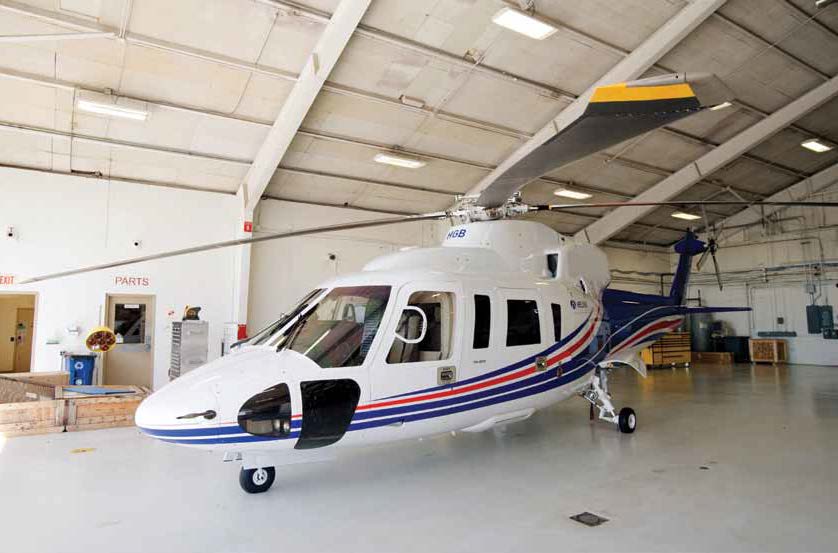
If you are into Tom Clancy novels or the exploits of Seal Team 6, then you quickly form a picture of “special missions” in your mind. If that were the case for this article, since you probably do not have the required security clearance, you know what comes next. I could tell you about the special mission equipment … but then I would have to kill you. Fortunately, this is not the case. Special mission equipment for helicopters is as varied as the helicopters themselves. Special mission equipment could be the installation of a Bambi Bucket for fire fighting, or a rescue hoist and litters for search-and-rescue operations, sophisticated avionics for maritime surveillance and coastal patrol, or searchlights and infrared detectors and monitors for law enforcement organizations. There are a host of other applications we could mention, but I think you get my drift.
The vast majority of these installations are not performed by the helicopter OEM. Usually, the end-user customer takes delivery of the helicopter from the OEM and then contracts with a third-party, full-service aviation center to install the special mission equipment. Third-party services can be provided by an FBO, MRO facility or a modification center. Whatever title the third-party installer goes by, they need to have an engineering department for design work and usually an in-house designated engineering representative (DER) to act as liaison with the FAA for design and engineering approval.
For this article, I worked with the staff of Summit Aviation in Middletown, DE, at Summit Airport (KEVY). It started operations in 1960 and is the oldest continually-operating aircraft company in the state of Delaware. The Greenwich Aerogroup purchased it in 2008. Summit Aviation has an extensive U.S. and international customer base that includes U.S. and international government, military and civil operators. It performs work on both fixed-wing and rotary-wing aircrafts. Its services include:
- Authorization to perform inspection, maintenance, repair and alterations to airframes, engines, systems and avionics
- Access to structural, systems and test pilot facilities capable of approving designs for structural modification/repairs, flight test/system analysis and human factors
- Airframe, engine, avionics and interior services for Bell, Boeing, Cessna, Eurocopter, King Air, MD-500, Quest and Pilatus aircrafts
- Full FBO services
- 24/7 AOG service with appointment
- Military/government MRO
- Cargo/utility/attack rotary-wing aircraft
A good rule to follow in any project, whether it is painting a room in your house or doing a special mission equipment installation on a helicopter, is to plan your work and then work your plan. At Summit Aviation, this starts with a project management overview process. This helps determine how the project will be driven. The project is broken down into key areas and departments within the company. The project being managed then drives the time line to be given to each area. The summary areas are:
Step One –Customer data gathering and design
Step Two – planning and methods
Step Three – engineering
Step Four – certification
Step Five – procurement
Step Six – operations
Step Seven –quality control/quality assurance
Step Eight – change orders
Step Nine – aircraft presentation/customer delivery
As you can see, there is more to an installation than just “plug it in and play with it.” Customers often just do not understand the complexities of an installation. All they know is that they want some type of display on the instrument panel and a controller in the center pedestal. What’s the big deal? Let’s take a look at the big deal to better understand the real complexities of a third-party equipment installation.
To begin, let’s suppose that a helicopter owner is interested in having some special mission equipment installed. What has to happen first? From what we see listed above, it is necessary to gather customer data and design information. This allows an accurate work specification to be created, priced and timed. Meeting with representatives of the company that owns the helicopter helps Summit Aviation learn what the customer’s typical flight profile is, and whether or not any maintenance and inspection items are due. Are there any avionics repairs or upgrades to be accomplished? This helps to determine/evaluate the customer’s schedule expectations.
From these meetings, the sales team can assemble the first draft of the work scope specification. Then the design, sales and operations teams meet to review the company’s requests and determine the cost and down time required on the helicopter.
Final meetings are held with the customer or their representative to finalize as required:
- The final scope of the work
- Design materials and color boards (if required)
- Cabin configuration (if required)
- Aircraft input and delivery (downtime)
Now, the finalized documents become what are termed “deliverables” to the customer that include:
- A frozen customer design specification
- A frozen design material callout and color board (if required)
- Design drawings and illustrations
- A job-specific master schedule
Once the customer or their representative has approved the deliverables and signed the contract, Summit Aviation can move forward with engineering and procurement. If the customer requests changes after this has occurred, than a change order process takes place. This can have ramifications that include change in cost, materials and down time.
Data Gathering
The first step in the work process is data gathering. Some of the questions that could arise that would have an impact on the cost and time to completion are:
- How does the number of helicopters to be modified come into play? The number of helicopter installations does not affect the design and data gathering process; however, it could affect the project cost as bulk buy vendor discounts could apply for multiple helicopter installations.
- Where will the work be done?Work can be accomplished in house or at the customer’s facility. However, when work is done in house, all resources are available to the installation team, whereas there might be limited installation resources at the customer’s facility.
- Will any part of the helicopter’s structure need to be physically changed?The structure would be changed only to accommodate equipment being installed, i.e., antennas, support structures or fuselage modifications.
- How about weight and balance considerations?As part of the data-gathering process, the helicopter’s weight-and-balance requirements are recorded and are adhered to during the design process to ensure and maintain safety of flight and proper balance.
How about power distribution? Again, as part of the data-gathering and design process, the power requirements for specific equipments being installed or modified are adhered to, and if necessary, additional support equipment may be required (alternators, generators, inverters, batteries, etc.)
Planning and Methods
The second step is planning and methods. Here Summit Aviation looks at what the actual installation steps are that need to be followed. The questions answered here are:
- What are the actual installation steps that need to be followed? First, we receive and review the signed customer contract. We then contact vendors/manufacturers to verify parts availability, procurement processes, lead times, etc. Next we ensure that hangar space, manpower and tooling are available. If something is not available, we acquire it through space procurement, contract labor and the lease/purchase of tooling as necessary. Last but not least is to create a work order.
- Is an STC involved? If no installation process exists, then we would apply for an STC, or submit a Form 337 through the FAA.
- At what points in the process are FAA approvals required? The FAA needs to be told when the project begins. They must also approve the installation prior to sign off (end of project). Between the beginning and the end of the project, the FAA has limited involvement.
- How is the length of time for each step determined? Department heads and team leads meet and review the scope of the work and determine best practice installation methods and time requirements.
- How does ordering parts and availability enter the timeline? Prior to determining the project schedule, the project manager needs to contact vendors/manufacturers to secure parts availability and lead time. As the saying goes, “He who has the parts determines the schedule.”
Engineering
The third step in the process is engineering. This is where the drawings are made to become the blueprint for the installation. Discussions here are:
- Do we have DERs on staff?Summit Aviation has one DER on staff (electrical) and access to others through our sister company.
- From initial meetings through drawings and review with the customer, what steps and personnel are involved? The DER would meet with the project manager to determine engineering and design requirements for the installation. The DER gathers the information needed to develop the drawings (measurements, configurations, design specifications, etc.). The DER then presents the project manager with the required drawings for the installation.
- Preliminary drawing lists will be created for structural drawings, electrical drawings, assembly and installation drawings. The preliminary drawing lists will identify what drawings are required to meet the work scope requirements of the design specification. After these drawings are created, they are given the proper number within the engineering numbering system.
- As the drawings are started, major materials are assigned to the drawings in the form of a preliminary bill of material. Engineering will forward these bills of materials to procurement to use so that proper parts and part numbers are ordered.
- As drawings are created, they will be distributed to operations so that fabrication can occur. Quality control will review the drawings in relation to the design specification, process specification and best practices to ensure that the product can be properly fabricated to meet the customer’s requirements and best practice fabrication requirements. If a change is needed to a drawing, the drawing will be “redlined.” If the change is significant requiring a different type of material or design, an engineering change request will be created so that the drawing is materially altered.
- As drawings are modified, they are released to the floor as a new revision level. The engineering manager or quality control will collect all previous drawings and issue the new drawings to the production floor so that the proper drawing is used at all times.
- When a task is complete in the production process, engineering will submit the most recent engineering drawing for that task, so that quality control can conduct a company inspection or conformity against that drawing and task, and confirm that the drawing matches the completed task. If a discrepancy is found against the drawing or task, the DER determines if the drawing or the task should be modified. If the drawing is to be modified, a new revision level is created to reflect the changes.
- At the end of the production process, a final master drawing list, drawing package and bill of materials is submitted along with the certification process to the FAA for the STC.
Certification
The fourth step in the work flow is to obtain certification for the work being accomplished. Should an STC be required, Summit Aviation would follow the following steps to receive STC approval:
- Submit the STC application to the FAA.
- The FAA issues a project number.
- The STC-approval process can now begin.
- The FAA reviews the scope of the work to be performed, the specifications that have been determined, etc., and then guides the project to completion.
- Throughout the course of the project, the FAA maintains contact with Summit Aviation and ensures that all work is in compliance with regulations
- When the project is complete, the FAA reviews, approves and signs off on the STC.
- The certification team takes the customer design specification and the master schedule to create the initial certification plan that is required to submit for an STC project number. The certification team also identifies and documents the configuration of the aircraft that will be the basis for the certification and engineering drawing package to the FAA or designee.
Throughout the fabrication and installation of the completion, the certification team creates, documents and monitors the results of bum testing on materials and material build ups, conducts engineering analysis of the installation, creates ground test plans and flight test plans, creates flight manual supplements to the existing flight manual, and creates instructions for continued airworthiness (ICA).
After all requirements have been met successfully, the certification team submits the entire data package to the FAA for approval. Upon the issuance of a type inspection authorization (TIA), the certification team works with the FAA, while the FAA reviews and comments on the data package, installations and ground tests. The certification team will accompany the FAA and designated airworthiness representative (DAR) on the required flight tests, and coordinate any changes required by the FAA with engineering or operations.
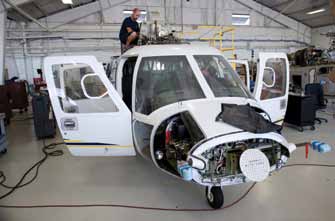
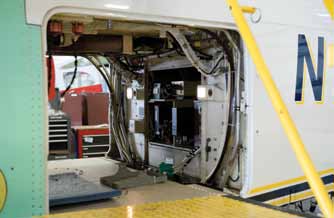
Procurement
As in any installation, getting all the bits and pieces together when required is a bit more difficult than going to the local Radio Shack store to buy some coaxial cable. The fifth step in the work flow is procurement. Procurement not only has to get the special mission equipment, but the required cabling, connectors and miscellaneous bits and pieces required. In some instances, availability and lead times to obtain what is required will have a serious impact on the length of time the project will take. Some considerations looked at here are:
- The preferred method for ordering parts is in kit form.
- If a kit is not available, then the parts are ordered individually. (Groan.)
- All parts are purchased via purchase orders which are submitted to the appropriate vendors/manufacturers.
- Accounting monitors outstanding purchase orders to ensure no delays in the project schedule.
Operations
The sixth process in our work flow is operations. This is where the actual installation of the special mission equipment happens. Any special fabrication of any kind also occurs during this phase of the work flow process. Operations uses the master schedule to drive all the milestones for maintenance, fabrication and installation.
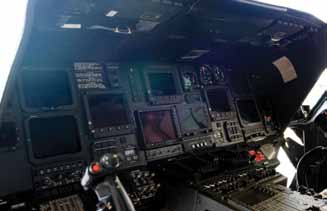
The key inputs for the production team are the customer design specification, the design drawings and illustrations and the engineering drawings. The production team’s primary vehicle for fabrication is engineering drawings and the process specification. The technical fabrication of the components is driven by these. Should there be an aesthetic design to the installation, this is driven by the customer design specification and design drawings and illustrations. If inconsistencies are found or roadblocks are experienced during the fabrication and installation process, the production team notifies the design team, sales team and/or engineering team for additional guidance and direction.
Quality Control/Quality Assurance
- The seventh process in our work flow is to assure and control quality during the fabrication, installation and testing of the installation work being performed, as well as to return the aircraft to service.
- To be able to do the above, the inspection department must:
- Maintain the repair station to current rules and regulations
- Administer the quality manual
- Conduct and manage training
- Manage mobile repair parties
- Maintain and update the process specifications
The inspection department’s first responsibility during a specific project is to take the customer design specification and create the work order. Throughout the project, the inspection department also maintains the work order through the addition of change orders. During the maintenance, fabrication and installation phases of the project, the inspection department or their designee will observe and sign off on each task done within the item numbers of the work order, confirming that the work was completed and completed properly. The inspection department also conducts company conformities to confirm that the work completed matches the drawings that have been generated. If there are errors on the engineering drawings, the inspection department will document “red lines” on the drawings and return the drawings to the engineering team so that the drawings can be updated.
Finally, during the project, the inspection department oversees the receiving of parts, materials and services, as well as bum build ups to make sure all FAA regulatory requirements are met.
During the operational checks of the project, the inspection department witnesses all tests conducted by the operations team and the certification team. The inspection department will conduct, calculate and document the weight and balance for the helicopter, as well as handle all issues related to returning the aircraft to service.
Change Orders
If you have been in the business of doing aircraft installations, more than once you have heard some manager somewhere screaming “time is money.” The longer it takes to do the installation, the more money it costs. Changes to the original work plan can occur during all projects and the improper management of a change can become an unwarranted expense. Changes are initiated externally by the customer and/or customer representative. The eighth process in our work flow is change orders. This allows us to manage changes that occur during the project properly. When a change request is made externally or internally, the sales team, design team and/or operations team reviews the change request to determine:
- Is the change of such a nature that it must be presented to the customer for approval?
- Will the change incur a new charge to the customer or will it be a no-charge change order?
- If there is to be a charge, how much will the charge be?
- Will there be a schedule impact, and if so, what?
The change order is then created. If the change is for internal purposes only, the change order is used as a vehicle to have a new item added to the work order through the inspection department. The change order then goes through the planning and methods process.
If the change requires customer approval, it is submitted to the customer. No more action is taken if the customer denies the change order. If the customer approves the change order, then a new item is added to the work order and the change order goes through the planning and methods process.
In the planning and methods process, if an impact was made to the schedule, the work schedule is modified and republished to the customer. If the change results in an engineering change, then an engineering change request is created and routed to the engineering department so the proper drawings can be amended. If the change is to be reflected on an engineering drawing, the purchasing department works with the engineering department to identify the proper part number so the bill of material can be changed. If the engineering department is not involved, then the purchasing department creates a purchase requisition form for the generation of a new purchase order.
Although change orders can and do occur and are an accepted procedure in installing or modifying systems, they are recognized as being detrimental to staying on budget and on schedule.
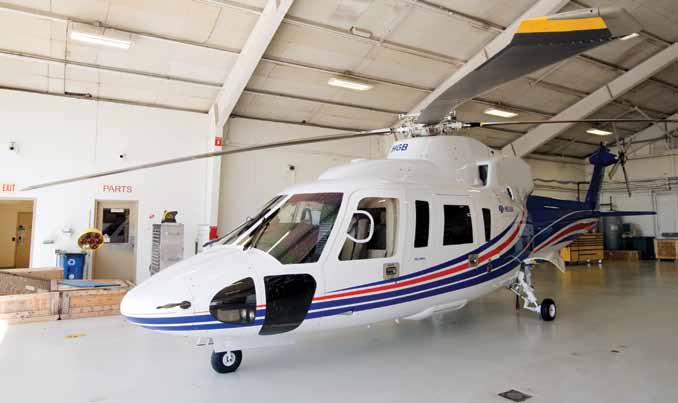
Aircraft Presentation/Delivery
Now that all the work has been completed, we come to the last step in the work flow and that is to present the aircraft to the customer for approval and delivery. Once the customer approves the work and accepts the aircraft, it is considered “successfully delivered.” To do this, these final procedures must be accomplished:
- All work on the aircraft has been completed and signed off.
- The aircraft has completed the weight-and-balance process successfully.
- The quality assurance department has reviewed the aircraft log books and aircraft data to ensure accuracy and compliance.
- The quality assurance department finalizes the work order and all associated paper work.
- The project manager contacts the customer/representative to arrange for the delivery of the aircraft.
- The customer/representative inspects the aircraft and reviews all of the applicable paper work with QA (work orders, discrepancies, project details, etc.).
- The customer/representative accepts delivery of the aircraft.
- The customer/representative and the aircraft leave the facility.
As you can see, installing equipment — special mission or any kind — in a helicopter is not just “plug it in and play with it.” That might work on your iPad, but not on your helicopter. The steps employed are many, but are in place to ensure the best possible installation at the lowest cost and least amount of aircraft down time. If it is worth doing, it is worth doing right the first time and every time.
My thanks to the great staff at Summit Aviation for their help in writing this article.
